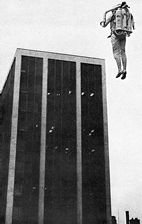2UE Flying Wing

Boy would I like one of these. It is So James Bond.
You might remember your jet packs from the 1960s. You strap them on your back and go flying through the air, propelled by gas.
They are nothing compared to this.
A German engineering firm has developed a jet-powered flying wing and unveiled it an airshow.
It's basically a strap-on aircraft and at this stage its use is going to be restricted to elite paratroopers.
Over the past couple of decades aeronautical engineers have made enormous breakthroughs in the technology we use when we jump from great heights.
You might have seen the wing suits that a Sydney couple used two weeks ago when they set a world base jumping record in India.
These are nylon suits with fabric under the arms like a bird's wing.
When they pulled taught they create an aerofoil shape a little like a plane's wing. Normally when a jumper leaps from a very tall height they can reach a velocity of about 190km/h.
The wing suits give lift to jumpers and let them slow their downward speed to as little as 45km/h and increase their forward speed to about 145km/h.
Another variation on this which has become increasingly popular in recent years is the flying wing.
Instead of a suit, jumpers strap on a two-metre carbon fibre wing and are dropped from an aircraft.
The wing weighs about 20 kg and because it has the same aerofoil shape as a plane's wing, again it provides lift and slows how fast the wearer is falling vertically.
In 2003 we saw an Austrian daredevil cross the English channel with one of this wings strapped to his back.
What this German firm has done is take things a step further.
They've got a carbon fibre flying wing and installed twin turbo jet engines in it.
While a regular flying wing can take parachutists up to 50 km from where they have been dropped these jets allow you to zoom nearly 200 km away at speeds over 150km/h.
ESG says its device is perfect for groups like the SAS. You drop them say 100km from a national border and they can silently jet across into a foreign country wearing these wings.I spoke to academics at the Australian Defence Force academy and they said the SAS will very likely be checking these things out.
That's right, this is one for all those Star Wars fans out there and another case of science catching up with science fiction.
If you've seen the original films you probably remember a scene where the hero Luke Skywalker is receiving some tuition from Obi wan Kenobi about using his light saber.
To practice, Luke is using a little hovering sphere about the size of a soccer ball which jets away if he tries to strike it. If his concentration lapses it zaps with with a laser beam.
Now NASA and scientists at the massacheusetts institute of technology have made something very similar and demonstrated it in the International Space Station.
The floating sphere built by the techies looks just like the one in the movie. But rather than teaching light saber skills its designed to work as a repair drone, a satellite or part of a telescope.
About six years ago NASA thought it would re-think the way it operated satellites. Scientists thought it might make more sense to launch clusters of mini-satellites rather than one big bulky unit. It would be cheaper to get them into the air and if they operated in concert it wouldn't matter if one got zapped by a piece of floating space junk.
They commissioned some of the brightest engineering students to create some prototypes. What they came up with was soccer ball-sized spheres which float in zero gravity and can jet about using gas powered thrusters. The flying spheres use sensors and stabilisers to orient themselves in a room.
Last month astronauts on the space station tested one of these and found they could get around pretty well.
The next step is to adapt them. One use might be as repair drones which could float around in space and fix the exterior of space craft. The main use is likely to be as weather or communications satellites.


0 Comments:
Post a Comment
<< Home